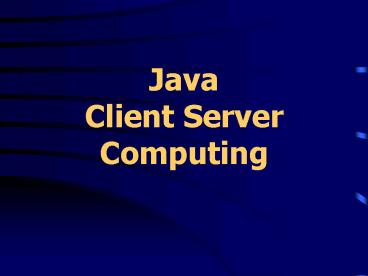Java Client Server Computing - PowerPoint PPT Presentation
1 / 22
Title:
Java Client Server Computing
Description:
A TCP/IP Socket is the Java object that connects a client to a network server ... (3) RMI requires Java VM to be run at both end. Communicating with HTTP Server ... – PowerPoint PPT presentation
Number of Views:59
Avg rating:3.0/5.0
Title: Java Client Server Computing
1
JavaClient Server Computing
2
C/S Computing on the Web
Client
Server
HTTP Server
Server API
Form
Post/Get
Applet
RMI
Servlets
JDBC/ODBC
CGI
Direct Socket Operations
DatabaseServer
ApplicationServer
3
Client-Server Programming in Java
- Programming network sockets
- Invoking distributed objects using Remote Method
Invocation (RMI) - Communicating with HTTP server
- Accessing remote databases using JDBC
- CGI programming
4
Programming Network Sockets
- A TCP/IP Socket is the Java object that connects
a client to a network server that is listening on
a numbered network port for a connection. - Sockets are used to implement reliable
bi-directional point-to-point, stream-based
connections between clients and servers on the
Internet.
5
Programming Network Sockets
- Client-side
- (1) Create a Socket object
- InetAddress address
- InetAddress.getByName(IP Address)
- Socket client new Socket(address,
- portNumber)
6
Programming Network Sockets
- (2) Create an output stream that can be used to
send info to the Socket. - PrintStream out new
- PrintStream(client.getOutputStream()
- (3) Create an input stream to read the response
from the server. - DataInputStream in new
- DataInputStream(client.getInputStream()
7
Programming Network Sockets
- (4) Process input and output with
handleConnection() method and other I/O methods. - ...
- (5) Close the socket when done.
- client.close()
8
Programming Network Sockets
- Server-side
- (1) Create a SocketServer object
- ServerSocket listenSocket new
- ServerSocket(portName)
- (2) Create a Socket object (multiple
connectionspossible) from the ServerSocket - Socket server listenSocket.accept()
9
Programming Network Sockets
- (3) Create an input stream to read input from the
client - DataInputStream in new
- DataInputStream(server.getInputStream)
- (4) Create an output stream that can be used to
send info back to the client - PrintStream out new
- PrintStream(server.getOutputStream())
10
Programming Network Sockets
- (5) Process input and output with
handleConnection() method and other I/O methods. - ...
- (6) Close the socket when done.
- server.close()
11
Remote Method Invocation
- RMI (Remote Method Invocation) is Javas
implementation of CORBA (Common Object Request
Broker Architecture). - RMI is an object-oriented version of RPC (Remote
Procedure Call).
12
Remote Method Invocation
- The client requests an object from the server
using a simple high-level language. Once it has
the object, it invokes its methods as though it
were a normal local object. (Behind the scene the
requests for the method are rerouted to the
server.) - Neither the client nor the server have to do
anything explicitly with input/output streams or
client/server sockets.
13
Remote Method Invocation
- Why Socket not RMI?
- (1) RMI only works among Java systems, not HTTP.
- (2) RMI requires common code to be installed on
both client and server. - (3) RMI requires Java VM to be run at both end.
14
Communicating with HTTP Server
- A HTML page can gather user input in two ways
(1) FORMs and (2) Java applets. Both can use
HTTP GET and POST methods for server interaction. - Java supports a much richer interface than do
HTML forms, but building interfaces in Java is
often more difficult than in HTML.
15
Using Java applets to send GET data to CGI
programs
- (1) The showDocument() method can be used to
request the browser to display a particular URL. - The URLEncoder.encode method can be used to code
the string being send into HTTP readable form. - (SearchService.java)
16
Sending Data via GET and Processing the Results
- If you are developing both the client and the
server end of the process, you can then have the
server CGI return data in non-HTML format and
have the client CGI process the data and present
it in graph or some other custom format. - (ShowFile.java)
17
Using Java Applets to Send POST Data to CGI
Programs
- If you are developing both the client and the
server end of the process, you can then have the
client CGI send POST data to the server CGI.
18
Java Database Connectivity
- JDBC is another API provided by Java for database
connectivity. - There are 7 steps to query database
- (1) Load the JDBC driver.
- String driver
- (connect.microsoft.microsoftDriver)
- Class.forName(driver)
19
Java Database Connectivity
- (2) Define the connection URL
- String url jdbcff-sybase//host/database)
- (3) Establish the connection
- String user username
- String password password
- Connection connection
- DriverManager.getConnection(url, user,
- password)
20
Java Database Connectivity
- (4) Create a Statement intance for query.
- Statement statement
- connection.createStatement()
- (5) Execute a statement.
- String query SELECT FROM table
- ResultSet results
- statement.executeQuery(query)
- (6) Process the resutls.
- (7) Close the connection.
21
Common Gateway Interface
- The CGI lets HTML pages communicate with database
or other programs on a system running an HTTP
server. - Instead of treating a CGI program as a file whose
content should be returned, the HTTP server
treats it as a program whose output should be
returned.
22
Common Gateway Interface
- So, a CGI program processes data from the client
and return the results. - A CGI program should perform 4 steps
- (1) Read the data.
- (2) Output HTTP headers.
- (3) Send a blank line.
- (4) Generate a HTML document.































